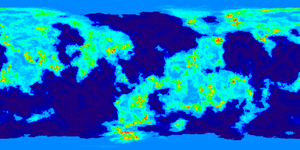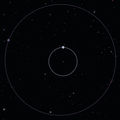Kerbin/pl
Kerbin jest domem rasy Kerbali, znajduje się na nim Space Center. W grze jest odpowiednikiem Ziemi. Posiada dwa księżyce, nazywane Mun i Minmus.
Kerbin trzecią planetą orbitującą centralną gwiazdę systemu - Kerbol. Jest trzecią co do wielkości planetą systemu (po Jool i Eve) i czwartym co do wielkości obiektem orbitującym Kerbol (po Tylo, jednym z księżyców Jool, który jest odrobinę większy).
Osiągnięcie stabilnej orbity nad Kerbinem jest jednym z pierwszych wielkich osiągnięć gracza. Osiągnięcie takiej orbity z trajektorią wznoszenia optymalną z punktu widzenia zużycia paliwa[1] wymaga delta-v równe od 4.45 do 4.7 km/s.[2] For many interplanetary missions, this represents over half of the flight's total delta-V requirement. (This is also true of Earth-based interplanetary spaceflights, leading one observer to remark that "If you can get your ship into orbit, you're halfway to anywhere."[3])
Contents
Topography
|
Kerbin has a roughly equal distribution of surface liquid water and solid land, with polar icecaps and scattered deserts. There are mountains exceeding 3 km in height, with the tallest peak being at least 3750 m in altitude.[4] |
Atmosphere
Kerbin's atmosphere contains oxygen and extends to roughly 69,078 meters. Its atmosphere becomes exponentially less dense as altitude increases (with a scale height of 5 km).[5] In general, the atmospheric pressure and density on Kerbin, at an altitude expressed in meters, are:
- (expressed in kg/m3)
Orbits
Geosynchronous orbit is achieved at an altitude of 0,00 m (1008.9 m/s). A semi-synchronous orbit with an orbital period of 1/2 of Kerbal (3 hours or 10800 seconds) is achieved at an altitude of 0,00 m with an orbital velocity of 0,00 m/s.
Interplanetary Travel
From the lowest stable orbit around Kerbin (70 km), the amount of delta-V needed to reach the orbits of other celestials is as follows:
| Body | Delta-V | |
|---|---|---|
| Mun | ~860 m/s | |
| Minmus | ~930 m/s | |
| Eve | ~1033 m/s | |
| Duna | ~1060 m/s | |
| Moho | ~1676 m/s | |
| Jool | ~1915 m/s | |
Reference Frames
| Paid (0.17) | Demo (0.13.3) | |
|---|---|---|
| Rotational/Inertial transition | 100,000 m | 70,000 m |
| Warp | Minimum Altitude | |
| 1x | Any | |
| 2x | n/a | 0 m |
| 5x | 69,078 m (above the atmosphere) | |
| 10x | 69,078 m (above the atmosphere) | |
| 50x | 69,078 m | 150,000 m |
| 100x | 120,000 m | 300,000 m |
| 1,000x | 240,000 m | 600,000 m |
| 10,000x | 480,000 m | 1,200,000 m |
| 100,000x | 600,000 m | n/a |
Gallery
- NJ6qJ.jpg
A projection map of Kerbin, as of 0.14.1 and before (including the demo).
An accurate full-colour projection map of Kerbin as of 0.14.2 and above.
Changes
- Improved atmosphere visuals.
- Minmus added.
- Much more varied and taller terrain added. Prior to this, some mountain ranges exceeded 600 m in height, but the tallest point was at an altitude of approximately 900 m.[6]
- Mun added.
- Terrain overhaul, oceans became wet.
- Atmosphere extended from ~34,500 m to ~69,000 m.
- Initial Release
Uwagi
- ↑ Trajektoria wznoszenia optymalna dla zużycia paliwa to taka, która (a)minimalizuje straty prędkości spowodowane tarciem atmosfery i oddziaływaniem grawitacyjnym i (b) jest skierowana na wschód (kierunek 90 stopni), dzięki czemu pojazd zyskuje 174.5 m/s prędkości orbitalnej za darmo dzięki rotacji planety.
- ↑ Kerbin Delta-V Chart
- ↑ Robert Heinlein, quoted on page 194 of A Step Farther Out by Jerry Pournelle.
- ↑ http://kerbalspaceprogram.com/forum/index.php?topic=11388.msg176509#msg176509 [Broken Link]
- ↑ Forum thread 16000, "[KGSS] Examining Kerbin's atmosphere"
- ↑ http://kerbalspaceprogram.com/forum/index.php?topic=6446.0 [Broken Link]






